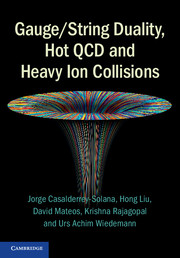Book contents
- Frontmatter
- Contents
- 1 Opening remarks
- 2 A heavy ion phenomenology primer
- 3 Results from lattice QCD at nonzero temperature
- 4 Introducing the gauge/string duality
- 5 A duality toolbox
- 6 Bulk properties of strongly coupled plasma
- 7 From hydrodynamics to far-from-equilibrium dynamics
- 8 Probing strongly coupled plasma
- 9 Quarkonium mesons in strongly coupled plasma
- 10 Concluding remarks and outlook
- Appendix A Green–Kubo formula for transport coefficients
- Appendix B Hawking temperature of a general black brane metric
- Appendix C Holographic renormalization, one-point functions, and a two-point function
- Appendix D Computation of the holographic stress tensor
- References
- Index
2 - A heavy ion phenomenology primer
Published online by Cambridge University Press: 05 July 2014
- Frontmatter
- Contents
- 1 Opening remarks
- 2 A heavy ion phenomenology primer
- 3 Results from lattice QCD at nonzero temperature
- 4 Introducing the gauge/string duality
- 5 A duality toolbox
- 6 Bulk properties of strongly coupled plasma
- 7 From hydrodynamics to far-from-equilibrium dynamics
- 8 Probing strongly coupled plasma
- 9 Quarkonium mesons in strongly coupled plasma
- 10 Concluding remarks and outlook
- Appendix A Green–Kubo formula for transport coefficients
- Appendix B Hawking temperature of a general black brane metric
- Appendix C Holographic renormalization, one-point functions, and a two-point function
- Appendix D Computation of the holographic stress tensor
- References
- Index
Summary
What macroscopic properties of matter emerge from the fundamental constituents and interactions of a non-Abelian gauge theory? The study of ultra-relativistic heavy ion collisions addresses this question for the theory of the strong interaction, Quantum Chromodynamics, in the regime of extreme energy density. To do this, heavy ion phenomenologists employ tools developed to identify and quantify collective phenomena in collisions that have many thousands of particles in their final states. Generically speaking, these tools quantify deviations with respect to benchmark measurements (for example in proton–proton and proton–nucleus collisions) in which collective effects are absent. In this chapter, we provide details for three cases of current interest: (i) the characterization of azimuthally anisotropic flow, which teaches us how soon after the collision matter moving collectively is formed and which allows us to constrain the value of the shear viscosity of this matter; (ii) the characterization of jet quenching, which teaches us how this matter affects and is affected by a high-velocity colored particle plowing through it; and (iii) the characterization of the suppression of quarkonium production, which has the potential to teach us about the temperature of the matter and of the degree to which it screens the interaction between colored particles.
- Type
- Chapter
- Information
- Publisher: Cambridge University PressPrint publication year: 2014



